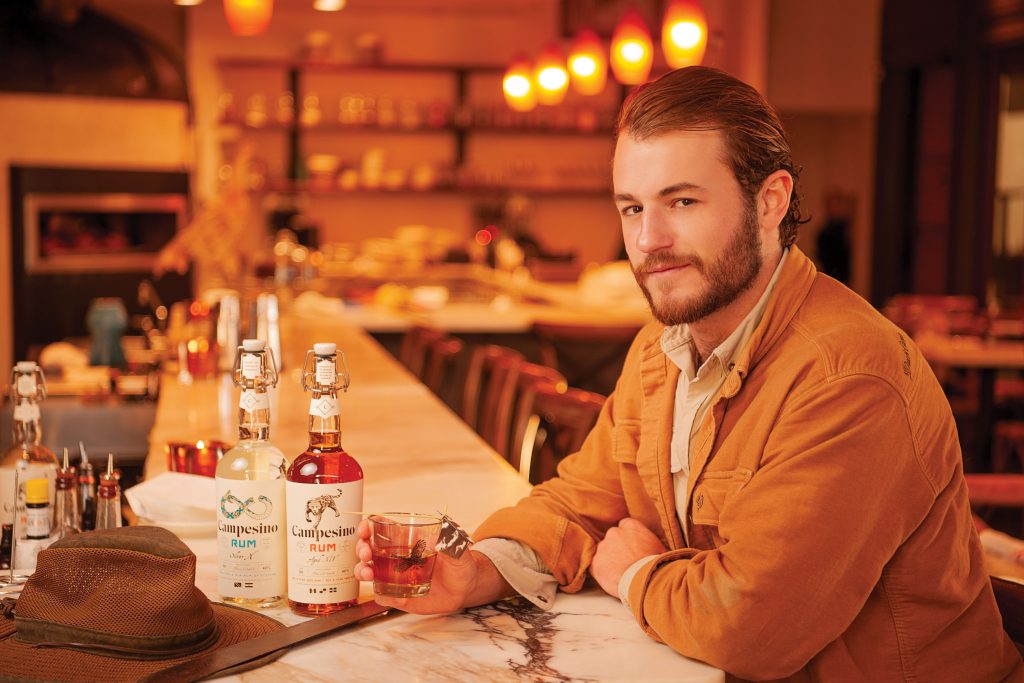Hatton Smith came back from the jungle a rum revolutionary. (Photography by Chuck St. John)
Hatton Smith’s revolution began with a large 125-gallon still, hidden in the jungles of Panama.
Or maybe it began quite a few years before that. It seems Smith, now 26, has always been a bit of a rebel.
“I have always liked doing my own thing,” Smith says. A member of the younger generation of the family that has operated Royal Cup Coffee for more than a century, Smith has an explorer’s nature.
“I’ve always had a sense of adventure. My grandfather on my mother’s side, Phillip Jackson, was an inspiration. A very international person. I have bene traveling ever since I was little. I would follow my dad around on his trips. I have always been super comfortable traveling. It is relaxing to me.”
He first went to Panama at 19, a few years before he found the still. “I was a hiking guide. I would lead photographers and scientists out into the mountains. I know all the trails. This was after my freshman year in college. I grew up in the coffee business so I have been in and out of Latin America and the coffee growing regions all my life,” Smith says.
He went back to school at Hampden-Sydney College in Virginia and studies abroad in Costa Rica, splitting his time between there and Panama. “I did a lot of surfing and hiking,” he says.
After graduation, he moved to New York and worked in commodities trading. “I was interested in markets and futures, and traded coffee, sugar cane and cotton. Again I didn’t like working for someone else.”
Smith headed out to California and went to work for a start-up in the cannabis industry that was trying to market cannabis-infused coffee. But he was soon on to the next thing. “The marijuana industry was very immature and not where I wanted to be, I was so used to the coffee industry.”
 Panama was calling. And the still in the wilderness was about to be discovered.
Panama was calling. And the still in the wilderness was about to be discovered.
There was no plan, Smith says. He and a friend ended up on a farm deep in the Panama wilderness. They found an old dome and created a house to live in on this farm, that Smith says was more like a commune.
Smith began selling coffee he roasted there in the wilderness to the locals, the campesinos, and the students. Then he found the still.
So soon his business involved selling both coffee that he roasted himself and rum that he created using the still and a particularly creative approach to fermentation. Like the campesinos that he had come to admire and count as friends, he was thriving in the wilderness.
“Campesinos are like magicians when it comes to thriving in the wilderness,” Smith says.
Smith saw promise in the rum he was learning about and making. “The still experience was great, but it wasn’t a business.
He sought out distilleries throughout the rum region of the Caribbean and worked with them in creating a rum he could market in the states. That rum is Campesino, which you can find in many bars and restaurants throughout the city.
The secret to the flavor of Campesino rum is the blend. “It’s a very specific custom blend, that’s what we bring to market. What we don’t do is add sugar, flavor and coloring. The biggest complaint people have about rum is it is too sweet. We can take the flavors of those countries, extract and create a blend that is clean, pure and true,” Smith says.
“There is a place for the brown spirits drinker (the bourbon fan) in rum: most just don’t realize it,” he says.
“There is potential for Campesino is to be the leader of the rum revolution. I expect to see a rum boom. You will see brown spirits drinkers who like bourbon switch to find out what rum has to offer.”



